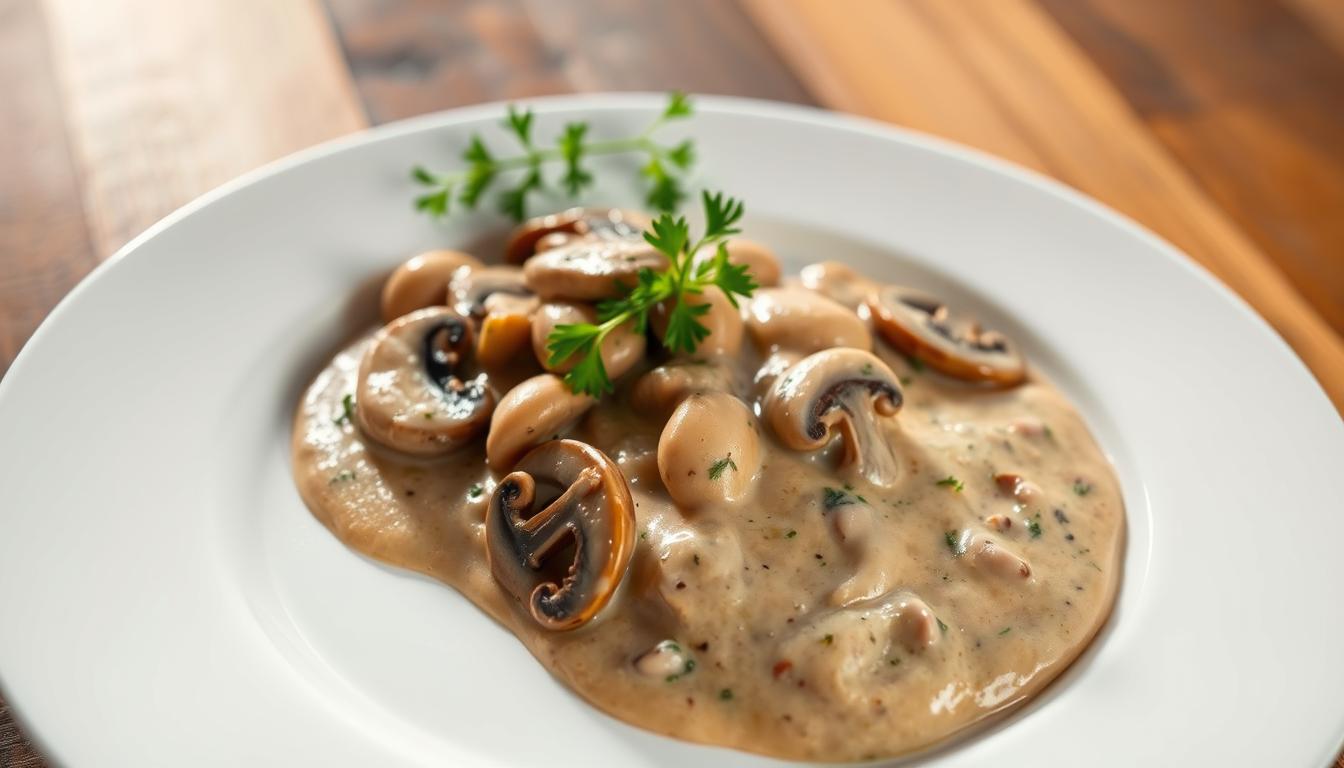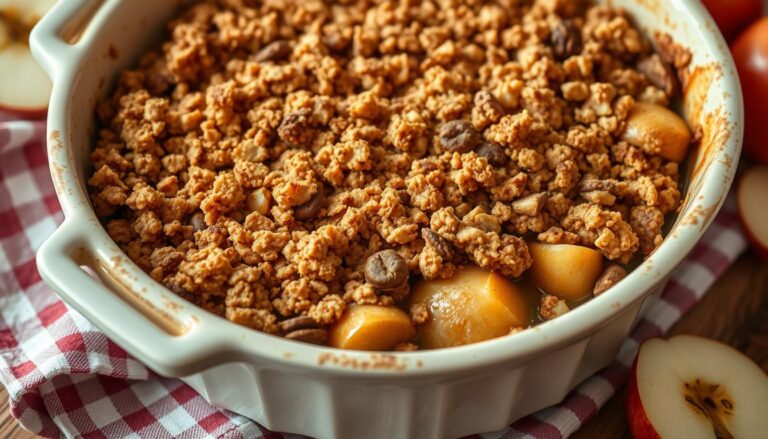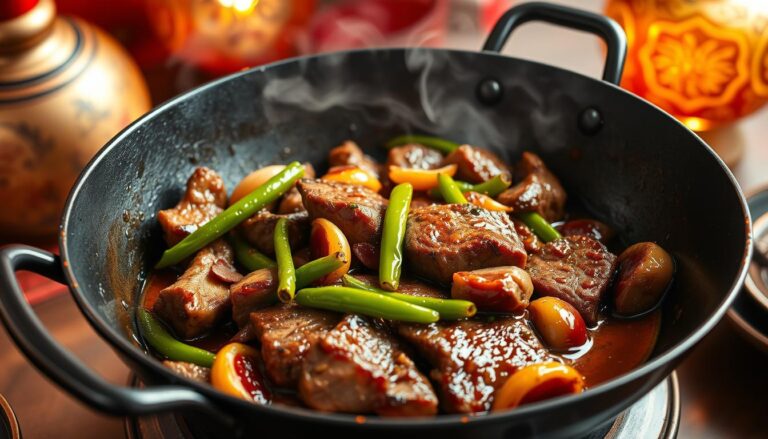Beef Stroganoff Recipe: Creamy, Savory, and Satisfying
There’s nothing quite like a warm, comforting meal that comes together in one pan. This classic dish combines tender strips of meat with a rich, mushroom-infused sauce for a flavor that feels both indulgent and cozy. Best of all? It’s ready in just 30 minutes, making it ideal for busy evenings.
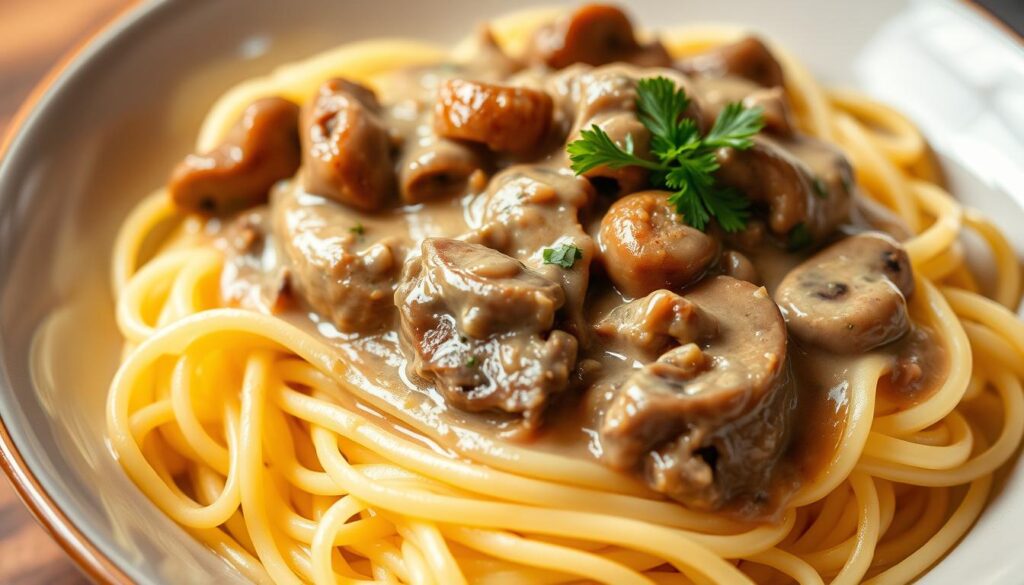
Quality cuts like top sirloin or ribeye add depth to the meal, while a velvety sauce—infused with garlic and onions—ties everything together. The secret to its silky texture? A careful blend of broth and tangy dairy, stirred in at the perfect moment to prevent curdling.
Serve it over buttery egg noodles or fluffy rice for a complete dinner. This timeless favorite has been refined through generations, and our step-by-step guide ensures even first-time cooks can nail it. No complicated techniques required—just straightforward, hearty goodness.
Key Takeaways
- Ready in 30 minutes with minimal cleanup
- Opt for tender cuts like sirloin or ribeye for best results
- Learn how to create a smooth, lump-free sauce every time
- Pairs perfectly with egg noodles or mashed potatoes
- Rooted in traditional cooking methods for authentic flavor
- Ideal for weeknights or impressing dinner guests
Introduction and Origins of Beef Stroganoff
Few dishes carry a legacy as rich as this creamy, mushroom-laden creation. Born in 19th-century Russia, it first graced aristocratic tables before winning hearts worldwide. The blend of tender meat and velvety sauce became synonymous with comfort, evolving through generations while keeping its soul intact.
Historical Background and Russian Roots
This iconic meal traces its name to Count Pavel Stroganov, a noted diplomat and food enthusiast. A surviving 1871 cookbook reveals one of the earliest written versions, describing it as “a harmony of sliced beef and sour cream”. Russian chefs perfected the balance of tangy dairy and earthy mushrooms, creating a luxurious yet approachable flavor profile.
Originally served at elite gatherings, the dish’s popularity soared due to its simplicity. Cooks could prepare it in minutes, relying on pantry staples like onions and broth. The cream-based sauce became its defining feature—thick enough to coat ingredients but light enough to let each element shine.
The Evolution to a Modern Favorite
By the mid-20th century, global adaptations emerged. American kitchens added paprika, while French versions leaned on wine reductions. Despite these twists, the core stayed true: a silky sauce hugging tender meat and mushrooms. Today, the term “stroganoff” signals comfort, whether served over pasta or modern grain bowls.
“It’s not just food—it’s edible history.”
From tsarist Russia to weeknight dinners, this dish proves timeless. Its journey mirrors culinary globalization, yet every bite still whispers of snowy St. Petersburg evenings.
Essential Ingredients and Quality Cuts
Great meals start with quality components. Each element in this dish plays a specific role, from creating texture to layering flavors. Choosing the right foundation ensures every bite feels balanced and satisfying.
Selecting the Perfect Beef
Not all cuts work equally well. Look for steak with visible marbling—those thin streaks of fat melt during cooking, keeping meat juicy. Top sirloin offers affordability without sacrificing tenderness, while ribeye adds richness. For special occasions, tenderloin delivers buttery softness.
| Cut | Tenderness | Best For |
|---|---|---|
| Top Sirloin | High | Weeknight meals |
| Ribeye | Very High | Rich flavor focus |
| Tenderloin | Extreme | Special dinners |
Dairy, Mushrooms, and Flavor Enhancers
The sauce’s velvety texture comes from sour cream and broth. Full-fat dairy prevents curdling, while fresh cremini mushrooms add earthy depth. Garlic and onions caramelize in the pan, building a savory base that ties everything together.
Don’t skip the “umami boosters”—a splash of Worcestershire sauce or Dijon mustard elevates the dish. These small touches transform simple ingredients into something memorable.
Preparing the Beef Stroganoff Recipe
Proper preparation transforms simple ingredients into restaurant-quality results. Let’s break down the techniques that ensure tender meat and balanced flavors every time.
Proper Slicing and Tenderizing Techniques
Start by placing your meat in the freezer for 15 minutes—this firms it up for cleaner slices. Always cut against the grain to shorten muscle fibers, making each bite melt-in-your-mouth tender. For extra softness, gently pound slices with a mallet or rolling pin.
Seasoning and Marinating Tips
Generously season slices with salt and fresh ground pepper 10 minutes before cooking. This draws out moisture for better browning. For deeper flavor, marinate in a mix of olive oil, garlic, and a splash of vinegar—acid helps break down tough fibers.
When searing, use a heavy skillet on heat just below smoking point. Work in batches to avoid overcrowding, which steams instead of caramelizes. Measure chicken broth and cream with a standard cup to maintain sauce consistency—too much liquid dilutes richness.
- Slice thickness: Aim for ¼-inch strips
- Marinating time: 30 minutes max to prevent mushiness
- Pan temperature: Medium-high for golden crust
Step-by-Step Cooking Process
Mastering this dish comes down to technique—timing, temperature, and layering flavors. Let’s walk through each stage to ensure your creation turns out silky, savory, and perfectly balanced.
Searing the Beef and Building the Base
Heat a large skillet over medium-high and add a drizzle of oil. Working in small batches, sear sirloin strips for 90 seconds per side. This locks in juices while creating a golden crust. Set meat aside once browned.

In the same pan, sauté diced onions until translucent. Add sliced mushrooms and minced garlic, stirring until caramelized—about 5 minutes. Sprinkle 1 tbsp flour over the mixture, coating all ingredients evenly. This step thickens the sauce naturally.
Crafting the Creamy Mushroom Sauce
Deglaze the pan with broth, scraping up browned bits for extra flavor. Reduce heat to low, then whisk in heavy cream and sour cream gradually. Stir constantly to prevent curdling. Season with pepper and a pinch of paprika for warmth.
Return seared strips to the skillet, simmering gently for 2-3 minutes. Finish with fresh parsley for brightness. The sauce should coat the back of a spoon—thick but still pourable. Serve immediately over your chosen base.
Mastering the Beef Stroganoff Recipe
The difference between good and great often lies in the details. Perfecting this iconic dish requires attention to two critical elements: heat management and sauce texture. Nail these, and you’ll create a meal that’s both luxurious and foolproof.
Managing Heat and Cooking Times
High heat is your friend when searing ribeye or similar cuts. A blazing-hot pan creates a caramelized crust while keeping the center tender. Work in small batches—overcrowding lowers the temperature, leading to steamed meat instead of seared perfection.
After browning, let the meat rest. This allows juices to redistribute, ensuring every bite stays succulent. Prep your button mushrooms and aromatics while the pan cools slightly. Timing matters: add dairy too early, and it might separate.
Achieving the Desired Sauce Consistency
The key to a velvety texture? Gradual incorporation. Remove the pan from heat before stirring in sour cream. For extra insurance, temper it by mixing a spoonful of warm sauce into the dairy first.
If the mixture feels thin, simmer gently—never boil. Too thick? A splash of broth adjusts it without diluting flavor. Serve alongside mashed potatoes to soak up every drop. Their creamy texture mirrors the sauce, creating harmony on the plate.
Season thoughtfully. Taste as you go, balancing tanginess with a pinch of paprika or dash of Worcestershire. With practice, these steps become second nature, turning a classic stroganoff recipe into your weeknight triumph.
Serving Suggestions and Creative Pairings
The right accompaniments can transform a great meal into an unforgettable experience. While classic options like egg noodles remain popular, modern twists keep this dish exciting. Let’s explore how to plate it for both comfort and flair.
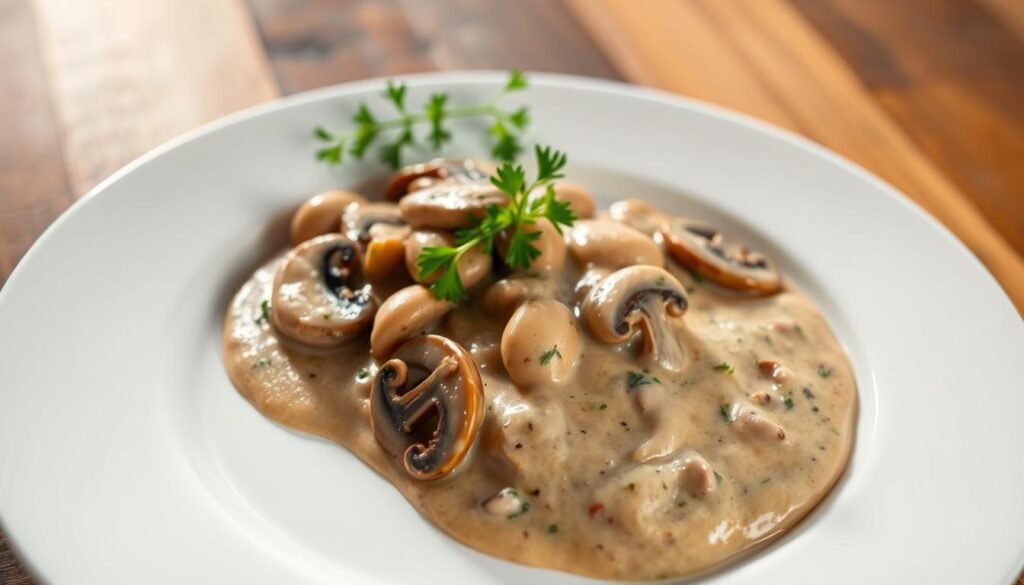
Best Bases for Every Occasion
Buttery egg noodles soak up the velvety sauce beautifully, creating that iconic bite. For a lighter option, try fluffy jasmine rice—its subtle sweetness balances savory flavors. Creamy mashed potatoes add rustic charm, especially when swirled with a spoonful of beef broth for extra richness.
Feeling adventurous? Golden polenta makes a stunning gluten-free base. Top it with strips beef and a sprinkle of fresh herbs. Want crunch? Toast crusty bread and layer it beneath the saucy mix.
| Base | Texture | Pairing Tip |
|---|---|---|
| Egg Noodles | Soft & Absorbent | Add 1 tsp Worcestershire sauce to cooking water |
| Mashed Potatoes | Creamy | Mix in roasted garlic |
| Polenta | Silky | Stir parmesan into the grain |
Presentation Perfection
Garnish matters. Chopped parsley or chives add vibrant color against the creamy sauce. For depth, sauté extra onions mushrooms separately and scatter them on top. A drizzle of beef broth around the plate keeps everything moist and photogenic.
Serve in shallow bowls to showcase the sauce’s glossy texture. Add a dollop of cup sour cream on the side for dipping crusty bread. For dinner parties, layer components vertically—noodles below, meat in the middle, herbs on top.
Remember: contrast creates appeal. Bright pickles or lemon wedges cut through richness. Even simple touches like black pepper grinders at the table make meals feel special. With these ideas, your dish will taste as good as it looks.
Enhancing Flavor and Customization Tips
Want to make this classic your own? Small tweaks can transform familiar flavors into something uniquely satisfying. Let’s explore how to adjust seasonings and ingredients without losing the dish’s soul.
Fine-Tuning Your Seasoning Strategy
Start by tasting as you cook. Add minced garlic in stages—sauté half early for mellow sweetness, then stir in the rest later for punch. For deeper richness, let onions caramelize until golden brown. This unlocks natural sugars that balance tangy dairy.
Don’t shy away from bold spices. A pinch of smoked paprika or dash of soy sauce adds complexity. Just remember: “Season lightly, taste often.” Over-salting can overpower the dish’s delicate creaminess.
| Fat Option | Flavor Contribution | Best For |
|---|---|---|
| Butter | Rich, nutty depth | Slow-cooked sauces |
| Olive Oil | Grassy, bright notes | Health-conscious versions |
| Ghee | Toasted aroma | High-heat searing |
Swap proteins easily. Try thinly sliced chicken or portobello mushrooms instead of meat. For extra veggies, toss in spinach or roasted peppers during the final simmer. Keep the skillet on medium-low to prevent the sauce from breaking.
Fresh herbs like dill or thyme add brightness. Stir them in just before serving to preserve their vibrancy. Balance is key—every addition should enhance, not compete with, the creamy base.
Conclusion
Creating a memorable meal often balances simplicity with skill. Focus on quality ingredients—like well-marbled cuts that melt into tenderness—and master heat control during cooking. A golden sear locks in juices, while gentle simmering keeps sauces velvety.
Don’t fear a little fat. It carries flavor and creates that luxurious texture we crave. Pair it with fresh mushrooms and tangy dairy for balance. Even small steps—like slicing meat against the grain—make a big difference.
This dish thrives on experimentation. Try different herbs or swap bases to match your mood. The joy lies as much in the cooking process as the final plate. Whether it’s a quick weeknight fix or a weekend project, let technique guide you.
With these tips, every bite becomes a celebration of rich flavors and smart cooking. Now grab your skillet, trust the method, and make it your own.
FAQ
Can I substitute sour cream with a lighter dairy option?
Yes! Greek yogurt or crème fraîche work well for a tangy, lower-fat alternative. Avoid boiling the sauce to prevent curdling.
What’s the best noodle substitute if I don’t have egg noodles?
Wide pappardelle, fettuccine, or even mashed potatoes pair beautifully. For low-carb options, try zucchini ribbons or cauliflower rice.
How do I prevent the meat from becoming tough?
Use quick-cooking cuts like sirloin or ribeye, slice against the grain, and avoid overcrowding the pan. Overcooking is the main culprit!
Can I make this dish gluten-free?
Absolutely. Swap all-purpose flour with cornstarch or a gluten-free blend, and ensure your broth and Worcestershire sauce are GF-certified.
Why do my mushrooms release so much liquid?
Sauté them on medium-high heat without stirring too often. This helps evaporate moisture and enhances their caramelized flavor.
Can I prepare stroganoff ahead of time?
Cook the components separately, then combine gently before serving. Reheating may cause the dairy to separate, so add fresh sour cream at the end.
What herbs elevate the sauce’s flavor?
Fresh dill or thyme adds brightness, while a pinch of smoked paprika lends depth. Finish with parsley for color.
Is frozen beef suitable for this recipe?
Thaw it completely and pat dry before cooking. Frozen meat retains excess water, which can affect browning and texture.
Can I add vegetables like peas or carrots?
Sure! Blanch firmer veggies first to avoid sogginess. Stir in peas just before serving to maintain their vibrant color and crunch.
How long does leftover stroganoff keep in the fridge?
Store in an airtight container for up to 3 days. Reheat gently on the stove, adding a splash of broth to revive the sauce’s creaminess.

